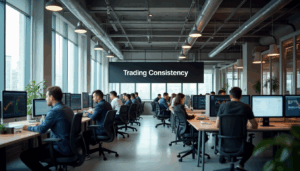Top CFD Trading Risks in 2025: What Pro Traders Must Know


CFD trading is attracting more professionals than ever, with over 80 percent of retail CFD traders losing money according to recent statistics. Surprising, right? The real twist is that the top risks in 2025 are not just about volatile markets or quick losses. Pros are facing a new set of dangers hidden deep within leverage mechanics, liquidity gaps, and evolving regulations—challenges that can trip up even the most experienced traders.
Table of Contents
- Leverage And Margin: Double-Edged Sword
- Liquidity Challenges And Price Slippage
- Counterparty And Regulatory Risks For Pros
- Advanced Risk Management Strategies For Funded Traders
Quick Summary
| Takeaway | Explanation |
|---|---|
| Leverage and Margin Require Vigilance | Traders must understand that leverage can amplify both gains and losses significantly, making it crucial to implement strict risk management protocols. |
| Liquidity Fluctuations Impact Execution | Varied liquidity in CFD markets can lead to execution challenges and price slippage, so selecting high-participation instruments and timing trades wisely is essential. |
| Counterparty Risk Demands Due Diligence | Comprehensive evaluation of brokers’ financial stability and regulatory compliance is vital to mitigate counterparty risks in CFD trading. |
| Adaptive Risk Management Is Key | Employing advanced techniques like algorithmic risk assessment, scenario planning, and dynamic hedging can enhance risk management strategies to better navigate market volatility. |
| Regulatory Awareness Enhances Strategic Advantage | Staying informed about evolving regulatory standards not only ensures compliance but also provides a strategic edge in the competitive CFD trading landscape. |
Leverage and Margin: Double-Edged Sword
CFD trading presents traders with powerful financial instruments that can dramatically amplify potential gains—and equally significant potential losses. Leverage and margin represent critical mechanisms that enable traders to control substantially larger market positions than their actual account balance would typically permit. While these tools offer extraordinary opportunities, they simultaneously expose traders to substantial financial risks that demand profound understanding and meticulous management.

Understanding Leverage Mechanics
Leverage in CFD trading functions as a multiplier that allows traders to open positions far larger than their initial capital investment. For instance, a 1:30 leverage means a trader can control a $30,000 position with just $1,000 of personal capital. Research published in The Journal of Finance demonstrates that increased trader leverage can negatively impact portfolio performance when investors fail to monitor positions closely.
The mathematical implications are profound. A mere 3% market movement could potentially generate a 90% gain or loss relative to the trader’s initial investment. This exponential risk exposure means traders must develop exceptional risk management strategies and maintain rigorous discipline. Professional traders understand that leverage is not a guaranteed path to wealth but a sophisticated tool requiring surgical precision.
Margin Call and Liquidation Risks
Margin trading introduces another layer of complexity through margin calls and potential account liquidation. When a trader’s account equity falls below a predetermined threshold, brokers can automatically close positions to prevent further losses. According to financial research, traders engaging in excessive margin trading frequently experience adverse portfolio performance.
The margin mechanism operates like a sophisticated financial safety valve. If a trader’s position moves against them and their account lacks sufficient funds to maintain the position, a margin call is triggered. This event can result in forced position closure, potentially locking in substantial losses. Experienced traders mitigate these risks by:
- Maintaining robust risk management protocols
- Implementing strict stop-loss strategies
- Continuously monitoring account equity levels
Strategic Risk Mitigation
Successful CFD traders recognize leverage as a precision instrument, not a blunt weapon. Effective risk management involves setting conservative leverage levels, understanding total exposure, and creating comprehensive trading plans that account for potential market volatility. Traders should never risk more than 1-2% of their total account value on any single trade.
Professional traders often utilize advanced evaluation processes to refine their risk management skills. By systematically testing trading strategies and understanding leverage dynamics, traders can transform this double-edged sword from a potential threat into a strategic advantage.
Ultimately, leverage in CFD trading represents a powerful yet dangerous tool. Mastery requires continuous learning, disciplined execution, and an unwavering commitment to sophisticated risk management techniques.
To clarify the benefits and risks associated with leverage and margin trading, the following table summarizes key aspects mentioned in the section:
| Aspect | Potential Benefit | Potential Risk |
|---|---|---|
| Leverage | Amplifies trading gains with smaller capital | Amplifies losses, can quickly deplete account |
| Margin Trading | Access larger market positions; more trading opportunities | Margin calls, forced liquidation if equity falls below threshold |
| Position Sizing | Control substantial market exposure | Exposes to amplified percentage losses |
| Use of Stop-Losses | Helps cap potential losses | May not always prevent liquidation in volatile conditions |
Liquidity Challenges and Price Slippage
Liquidity represents a critical yet often overlooked dimension of CFD trading that can dramatically impact trader performance and portfolio outcomes. Unlike traditional stock markets with consistent trading volumes, CFD markets experience significant fluctuations in liquidity that can transform seemingly stable trading strategies into unpredictable financial scenarios.
Understanding Liquidity Dynamics
Investopedia research highlights that liquidity risk emerges when insufficient buyers or sellers exist in the market, creating potential execution challenges. This phenomenon means traders might find themselves unable to enter or exit positions at desired price points, leading to unexpected financial consequences.
Liquidity variations occur across different market conditions, asset classes, and trading sessions. Forex CFDs typically maintain higher liquidity compared to more niche market instruments like exotic currency pairs or less-traded commodities. Professional traders recognize these nuanced differences and adapt their strategies accordingly, selecting trading instruments with robust market participation.
Price Slippage Mechanisms

Market volatility research indicates that rapid price movements can significantly increase slippage risks. Slippage happens when an order is executed at a price different from the expected level, potentially eroding potential profits or amplifying potential losses.
Traders experience slippage most acutely during:
- High volatility market periods
- Major economic announcement windows
- Low liquidity trading sessions
For instance, during significant economic events like central bank announcements, market participants might witness bid-ask spreads widening dramatically, creating substantial execution price differences. These moments demand exceptional situational awareness and strategic preparation.
Mitigating Liquidity and Slippage Risks
Professional trading platforms recommend several sophisticated strategies to manage liquidity challenges. Experts from IG suggest trading during high-liquidity market sessions and utilizing limit orders to maintain greater price control.
Effective liquidity risk management involves:
- Selecting trading instruments with consistently high market participation
- Implementing strict stop-loss and take-profit mechanisms
- Avoiding trading during known low-liquidity periods
- Maintaining flexible position sizing strategies
Traders must view liquidity not as a static concept but as a dynamic environmental factor requiring constant monitoring and strategic adaptation. Success in CFD trading demands not just market knowledge, but a nuanced understanding of market microstructures and execution dynamics.
To help illustrate the main causes and mitigation strategies for liquidity challenges and price slippage, here’s a summary table:
| Risk Factor | Description | Example Scenario | Mitigation Approach |
|---|---|---|---|
| Low Liquidity | Not enough buyers/sellers in the market | Attempting to exit a position in a rare commodity CFD | Trade popular instruments; avoid thin markets |
| High Volatility | Rapid price changes leading to slippage | Trading during a central bank announcement | Avoid trading during major events; use stop-losses |
| Wide Bid-Ask Spreads | Large gaps between buy and sell prices | Post-announcement, spreads widen sharply | Use limit orders; trade during active sessions |
Counterparty and Regulatory Risks for Pros
In the complex world of CFD trading, professional traders must navigate a sophisticated landscape of counterparty and regulatory risks that extend far beyond simple market movements. These risks represent critical factors that can fundamentally impact trading performance, financial stability, and overall portfolio management strategies.
Understanding Counterparty Risk
Counterparty risk emerges as a fundamental concern in CFD trading, where traders essentially enter into a contractual agreement with their broker. The European Market Infrastructure Regulation (EMIR) highlights the critical nature of managing these systemic risks in financial derivatives markets. This risk manifests when the broker or financial institution might fail to fulfill their contractual obligations, potentially leaving traders exposed to significant financial vulnerabilities.
Professional traders must conduct comprehensive due diligence on their chosen trading platforms. This involves evaluating the broker’s financial stability, regulatory compliance, capital reserves, and historical performance. Indicators such as regulatory licensing, transparency in financial reporting, and institutional backing become paramount in mitigating potential counterparty risks.
Regulatory Landscape Complexities
The Financial Stability Board’s proposed measures demonstrate the evolving regulatory environment surrounding financial derivatives. These proposals aim to enhance market stability through mechanisms like:
- Enhanced disclosure requirements
- Stricter leverage limitations
- Increased central clearing of transactions
- Comprehensive risk management protocols
Navigating this regulatory landscape requires traders to remain consistently informed about changing compliance standards. Traders can explore detailed evaluation guidelines to understand how professional trading platforms integrate these regulatory considerations into their operational frameworks.
Risk Mitigation Strategies
The Bank of England’s Prudential Regulation Authority emphasizes the importance of maintaining robust risk management strategies. Professional traders should implement comprehensive approaches to counterparty and regulatory risks:
- Diversify trading across multiple regulated platforms
- Maintain transparent communication with brokers
- Continuously monitor regulatory updates
- Develop adaptive risk management frameworks
- Maintain detailed trading records and compliance documentation
Ultimately, successful CFD trading in 2025 demands more than technical market knowledge. Traders must evolve into sophisticated risk managers, capable of navigating complex regulatory environments while protecting their financial interests. The most successful professionals view regulatory compliance not as a constraint, but as a strategic advantage in an increasingly complex global trading ecosystem.
Advanced Risk Management Strategies for Funded Traders
In the high-stakes world of CFD trading, professional funded traders require sophisticated risk management strategies that transcend traditional approaches. Advanced risk management represents a comprehensive methodology that combines technological innovation, psychological discipline, and strategic foresight to protect and optimize trading performance.
Algorithmic Risk Assessment Techniques
Research utilizing deep reinforcement learning algorithms demonstrates the potential for advanced computational strategies in managing trading risks across multiple asset classes. These sophisticated techniques enable traders to develop dynamic models that can simulate and predict potential market scenarios with unprecedented accuracy.
Professional traders now leverage complex mathematical models that incorporate:
- Machine learning predictive analytics
- Real-time sentiment analysis
- Multi-variable risk scoring systems
These algorithmic approaches transform risk management from a reactive process to a proactive, predictive discipline. By analyzing vast datasets and identifying subtle market correlations, traders can anticipate potential volatility and adjust strategies preemptively.
Scenario Planning and Stress Testing
Advanced trading platforms recommend comprehensive scenario analysis as a critical risk management technique. Experts suggest conducting rigorous stress testing that simulates extreme market conditions, allowing traders to understand potential portfolio vulnerabilities.
Effective scenario planning involves:
- Modeling potential market disruption scenarios
- Establishing predefined risk threshold limits
- Creating adaptive response protocols
- Quantifying potential loss magnitudes
Professional traders approach scenario planning like strategic military operations, developing multiple contingency frameworks that can be rapidly deployed in response to changing market dynamics.
Holistic Risk Integration Strategies
Emerging research in computational trading highlights the importance of integrating multiple risk management dimensions. This approach goes beyond traditional financial metrics, incorporating technological, psychological, and systemic risk factors.
Key holistic risk management components include:
- Continuous portfolio rebalancing
- Dynamic hedging mechanisms
- Psychological performance tracking
- Advanced computational risk modeling
- Systematic emotional discipline protocols
The most successful funded traders view risk management not as a constraint but as a competitive advantage. They develop comprehensive frameworks that transform potential vulnerabilities into strategic opportunities, maintaining psychological composure while leveraging technological innovations.
Ultimately, advanced risk management in 2025 demands a multidimensional approach that blends human intuition with computational precision. Traders must become sophisticated risk architects, constructing resilient trading strategies capable of navigating increasingly complex global financial landscapes.
Frequently Asked Questions
What are the main risks associated with CFD trading in 2025?
The main risks include leverage and margin risks, liquidity challenges and price slippage, counterparty risks, and evolving regulatory environments. Each of these factors can significantly impact a trader’s performance and financial outcomes.
How can professional traders mitigate leverage and margin risks?
Traders can mitigate these risks by maintaining strict risk management protocols, implementing stop-loss strategies, and continuously monitoring their account equity levels to avoid margin calls and potential liquidation.
What is price slippage in CFD trading, and how can it be avoided?
Price slippage occurs when an order is executed at a different price than expected, often due to high volatility or low liquidity. To avoid slippage, traders should use limit orders, select instruments with high market participation, and avoid trading during low liquidity periods.
Why is counterparty risk important in CFD trading?
Counterparty risk is crucial because it involves the possibility that a broker may fail to meet their financial obligations. Traders should perform due diligence on brokers, evaluating their financial stability, regulatory compliance, and market reputation to mitigate this risk.
Ready to Master CFD Risk in 2025? Prove It and Get Funded
Are you worried about leverage pitfalls, liquidity traps, or the relentless challenge of strict risk controls in CFD trading? You are not alone. This article highlighted how even the most experienced traders can stumble over risk management errors and regulatory shifts. To truly succeed today, you need more than skill—you need capital, a supportive framework, and a clear path to growth.

Step onto a professional stage where your strategy meets opportunity. At Earnex Prime, you can take an industry-leading evaluation challenge that puts your expertise to the test while you navigate real-world CFD conditions. Hit your targets under defined risk—prove you can manage leverage, avoid margin calls, and adapt to liquidity changes. Passing means you earn the capital to unlock high profit splits and institution-grade trading tools, all backed by transparent rules and broker support. Visit https://funded.earnexprime.com now to begin your path as a funded trader. Spots fill quickly. Take control of your trading future before the market shifts again.






